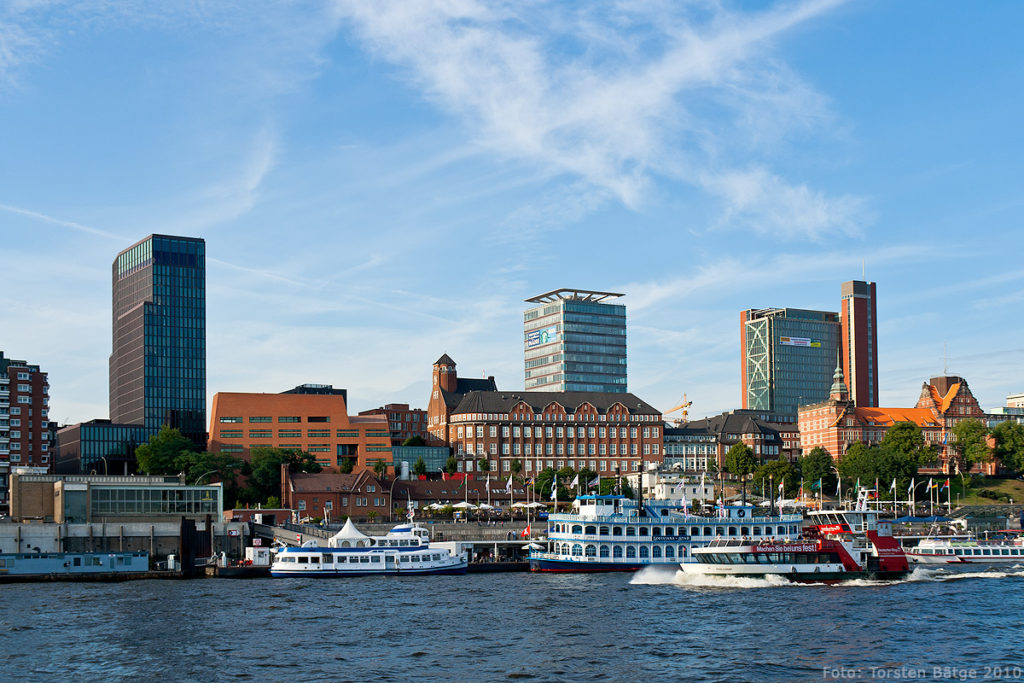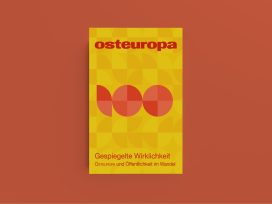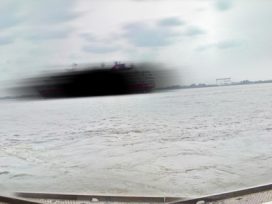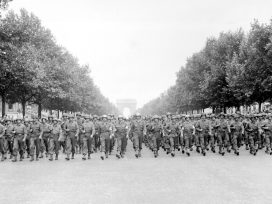The emblem of Hamburg, the closed gate in a castle with three towers, is a good starting point for exploring how the city became entangled in migratory and trade routes throughout the world. Imaginaries play a strong role in Hamburg’s self-representation, especially with regard to its current and historic role within the world’s trade and migration networks.

Auf dem alte Bavaria-Gelände oberhalb der St. Pauli-Landungsbrücken befindet sich die sogenannte Hafenkrone. Photo: Torsten Bätge / Wikimedia
Today, Hamburg’s harbour area is its most important tourist attraction, and dozens of cruise liners enjoy the warm welcome they receive when stopping over there. The function of the harbour area embedded within the city centre changed during the twentieth century – as in most other European harbour cities – from a scene of barter and trade to the scenic background for tourist adventures, leisure and expensive waterfront housing. This article draws special attention to the colonial roots on which this cityscape is built and how enduring transnational relationships shaped the city’s borders, helping to form what is perceived today as the multicultural city of Hamburg.
Sephardim: A network for economic prosperity
The migration history of Hamburg is entangled with many historic events around the globe, but the expulsion of the Sephardic Jews in Spain and Portugal in the aftermath of 1492 constitutes a special event in migration history. At the same time as Spanish conquerors discovered the “new world”, the reunification of the Spanish empire and the politics of Christianisation led to the mass expulsion of Jews from the Iberian states. With their migration to most of the important harbour cities in Europe, the Levant and the new world, the Sephardic Jews established a vast transnational network across the western hemisphere. As the network was used by the Sephardim for trade, this brought economic prosperity to receiving European harbour cities. There is little doubt how crucial these networks were to the prosperity of cities like Amsterdam, Florence, Venice and Hamburg, whose economic growth was based on trade.
Ladino, the common language of the Sephardim, became an asset even as the language excluded them from their receiving society. It became an asset in finding lucrative positions related to shipping and trading, as the Sephardim began to dominate the communication hubs in many European harbours. Thus the Sephardim built upon trade relations predating their expulsion from the Iberian Peninsula. Hamburg received a significant number of these refugees, using its migration policy to select the “haves” from the “have-nots”. Those Sephardim who seemed important or already enjoyed good relations with powerful inhabitants in Hamburg had the chance to reside within the walls. Others – the majority – were not so lucky. Unfortunately, extant records concerning the numbers refused entry at the gates of Hamburg remain scant.
Although Hamburg welcomed these Jews, it never became a place where they fully belonged. From the perspective of the economy, the gates of Hamburg were wide open – when it came to religious practice and social integration they were, as for many other migrants, closed. The graveyards of the Sephardic Jews in today’s district of Altona reflect the selectiveness of migration policy in the city of Hamburg. Formerly, Altona was an important city in its own right, outside of Hamburg, and in the seventeenth century it became the second largest settlement in the Danish Empire. A consistently migrant-friendly policy offered possibilities for new inhabitants, including with regard to their religious practice. The graveyards of Altona, with their rich decorations, ornaments and inscriptions in Portuguese and Ladino reflect both the prosperity and the depth of entanglement with patterns of migration – in which both cities were implicated.
The city’s walls have been porous in the past as well as the present. In the past, many of those rejected at the gates settled nearby in the city of Altona or in the east. Yet in their new homes in Altona, many Jews still profited from the economic power of Hamburg by operating as tradesmen inside or offering their services directly outside the walls. Then they were said to enjoy the “Große Freiheit” (Great Liberty) – a phrase associated today with one street in the red-light district. Be that as it may, thousands of people still stumble across the historically important border every day, marked by a historic pillar decorated with the emblem of the Danish Crown, situated in the middle of Hamburgs well-known red-light district Reeperbahn (German for ropewalk).
Colonial roots and routes of trade and migration
The Portuguese quarter at the harbour is well known today as a tourist destination. The city profits from its image as a “gate to the world” by promoting such quarters as an outcome of a foreigner-friendly city shaped by immigration. Known today for fish restaurants and dozens of cafés offering Galão, Portuguese croissants and Natas, the quarter was in the seventeenth century home to the first Portuguese settlers, who resided in poorly maintained sheds. Via those Sephardic networks, the city had access to Brazilian sugar cane and, consequently, to an important and valuable good: refined sugar. Planted and grown by mainly African slave workers in Brazil, transported on ships whose owners resided in Hamburg, it was processed in the harbour of Hamburg by mostly Portuguese immigrants. Sugar, therefore, provides a classic nexus between migration history and the colonial trade triangle.
Reaching Hamburg by sea means entering the river Elbe, where the scenery still impresses sailors and tourists on cruise liners alike. The complete harbour front is an architectonic expression of Hamburg’s and Germany’s role within the colonial system. Officially opened by chancellor Bismarck in 1884, the colonial period enjoyed a brief political career. Yet the system of power, trade and slavery had been in place long before this and Hamburg played – one could add “still plays” – a crucial role in the global networks that underpinned the exploitation of the so-called Global South. However, after Bismarck’s official political declaration in 1884, the costs of defence and protection overseas and during passage passed to the state. This reduced costs substantially, freeing up funds not only for the donation in 1906 of the tallest statue of Bismarck in Germany. This was erected at the top of the harbour and remains today a dominant observer of the harbour among the buildings of the so-called Hafenkrone.
The Hafenkrone (Harbour Crown), or buildings along the river shore, form a select and highly symbolic scenery of nautical institutions that once manifested the position Hamburg claimed within the colonial system. The original right peak of the crown is missing today – the castle-like naval observatory. The marvellous place overlooking the harbour is nowadays occupied by a youth hostel, offering rooms to many young travellers and tourists. The original buildings of the School of Navigation, Sailors Hostel and the Institute for Maritime and Tropical Diseases are still in place, though they have different occupiers. The School of Navigation hosts a meteorological station. The former medical institute, its problematic history aside, still functions as a hospital and research institute in the form of the Bernhard-Nocht-Institute, which is dedicated to overseas diseases. The Sailors Hostel continues to receive guests but is now a hotel. Wealthy tourists residing there might also arrive by boat, just as former immigrants and sailors once did – though the cruise liners have long since replaced more modest vessels. With the exception of one institution, all the buildings in this symbolic scenery still have travel and tourist-related functions of one kind or another, thus exhibiting the continuity of their colonial roots. And current migration flows through the harbour also hark back to colonial routes.
Cruise centres now and then: From permanent emigration to short-term mass tourism
Ruptures of all kinds of dimensions soon become apparent when comparing current trends on cruise lines with the conditions under which they were established in the eighteenth century – in order to carry millions of emigrants from European harbours to new worlds. But despite obvious differences, some structural elements remain constant. First of all, the routes and destinations have not changed significantly. Many of today’s cruise lines follow the routes to New York, West Africa or to the Caribbean that were already used centuries ago. Even some companies remain the same. Secondly, I would suggest as a hypothesis requiring further proof that the imaginaries of the unknown and the exotic inviting discovery continue to compel masses to survey the globe from the vantage point of the giant cruise liner. Only the direction of the flows has changed over time. Whereas before mass emigration removed populations from Germany to new worlds, today the port functions as a point of entry for organized, short-term mass immigration otherwise known as tourism.
The cruise centres in the harbour hosted 161 cruise liners in 2012, facilitating the arrival of some 242,668 tourists in the city. The huge Queen Mary II, Costa Pacific and the AIDA fleet feature among the regulars. The demand for cruise liners that stop over in Hamburg has grown so fast, that the new cruise centre built in the new quarter of harbour city reached its limits very quickly. The city opened a second newly built cruise centre in Altona in 2009, on a site that, from 1993 to 2006, was used to host the Bibby Altona, a floating detention centre for refugees and asylum seekers. With a capacity of over 500 people, this facility became symbolic of the city’s outcasts. Floating within the city’s boundaries, the detention centre functioned to separate out the “unwanted” refugees and keep them away from firm ground – a place of surreal belonging or a spatially isolated periphery within the centre. Still today – though under very different circumstances – the cruise liners that stop over in the same place now function in a similar way, as they perform as a spatially isolated social space within the city and transmit a very surreal feeling of belonging to their passengers. Only those possessing a valid tourist visa for Germany may enter and enjoy the city through the gates of the cruise centre, which performs in this case as a European border. For those who were not able to obtain a visa in advance, they have to remain on the boat. Isolated and integrated at the same time within the harbour, their vantage point offers luxury but at the same time demonstrates in a very symbolic manner the line that migratory policy draws.
Mass emigration from Germany started with a small “golden” book that can be translated as follows: “Detailed and circumstantial report of the famous country Carolina / Situated in British America”. Not a very promising title even in the original German and – imaginaries are crucial on both sides here – surprisingly, the author Josua Kocherthaler has never been to America. However, new settlers were always sought after for the purposes of English colonisation, and this German pioneer worked for the English. Starting with a first small wave of 13,000 German emigrants in 1703, the “Promised Land” constantly received new settlers from Germany’s hinterlands to work on the imaginaries and realities of America.
From 1850 onward, ships departing from the port of Hamburg for American destinations were frequently scheduled. HAPAG, Hamburg Lloyd, Cunard and many others still in business today profited from the poverty that drove mass emigration to promised new lands. Between 1850 and 1934, about five million emigrants passed through the port of Hamburg. The restored museum of Ballin Stadt in Veddel tries to represent the stories of those who migrated to build America. How many of those who left their home finally reached their destination overseas is hard to establish. For Hamburg, the constant inflow of emigrants from Germanys hinterlands not only meant a great outflow towards the new world, it also supplied growing city quarters with inhabitants who were too tired, sick or poor to migrate further. Emigration was also an economically interesting deal for the city. Not only did it bring economic prosperity to the ship-owning families. Many migrants had to wait some weeks until their vessels left, so they spent a great share of their money in shops, provisions stores and restaurants within the city.
Harbour cities as places of migration – harbours as no place of migration
Within the current framework of European border policies, international harbours constitute international borders and are therefore under strict control in order to avoid undocumented immigration. Border controls are in place in the harbour, but not crucial for the purposes of border control. More effective in this respect are the ship owners, who are now responsible for every irregular passenger they carry and, since the costs of remigration are passed to the ship owners too, they make great efforts in harbours of departure in the Global South to avoid carrying undocumented migrants inside European territory. This externalisation of border controls is claimed to have impacted greatly on the quantity of aliens on board, though sound evidence is hard to come by. Captains tend to avoid official police detection if someone is found on board a ship towed into harbour.
How to conclude in the midst of this entangled history of migration flows? One important insight is that Hamburg is still a place of migration – even though the harbour’s function has changed with regard to immigration. The function of the harbour has shifted to become a historical foil for its role as a scenic, migratory destination for tourists. Although the port of entry is the airport today, more long-term oriented migrants still select Hamburg and other European harbour cities for their transnational connections and the appeal of lively migratory populations rooted in the harbours historic role.









